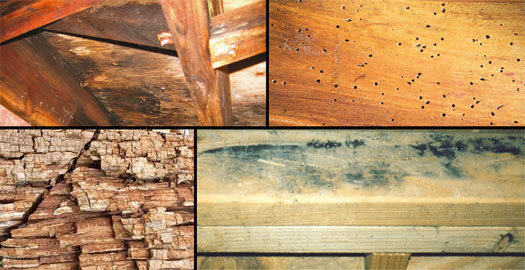
Wood decay and rot occur when moisture is present. Moisture in residential homes can be caused by leaking roofs, burst or leaking plumbing pipes, improperly graded yards, windows and doors that have lost their seals and poor indoor ventilation that allows the humidity from cooking, cleaning and showering to build-up. If you suspect wood rot as a home owner or real estate professional, you can test the area by pressing a screwdriver into the wood. If the wood flakes easily, it’s rotten and will need the services of a professional structural engineer to assess the damage and develop a plan for restoring the structural integrity of the home.
Fungus
Wood rot and decay is typically caused by fungus. Fungus spores are present in the air, but they do not grow without water. Typically, they need at least 20 percent moisture in order to flourish. When fungus spores start to multiply in wood, you may notice mushroom type growths on the wood or thin films that cover sections of the wood. In order to control fungi growth and stop wood rot, the source of the moisture must be identified and remedied. If the rot is exceptionally bad the wood may need to be replaced. Anti-fungus treatments may also be used to inhibit future growth.
Dry Rot/ Brown Rot
Dry rot is caused by brown rot fungi (Serpula lacrymans). In order for Serpula lacrymans to flourish, it needs a moisture content of about 20 to 30 percent. When most homeowners spot dry rot, the wood often appears dry, crumbly and brittle, which is where dry rot gets its name. The fungi that cause dry rot can grow in multiple structural components of the home, including wood, concrete, stone, mortar and even behind plaster. If it is not caught quickly, it can destroy 80 percent of the wood’s integrity within a relatively short period of time. Other fungi that cause brown rot include Coniophora puteana and Antrodia vaillantii.
White Rot
White rot is caused by Phellinus contiguus and Asterostroma. These are considered wet rots because they grow near active leaks or in areas of high moisture, like basements, crawlspaces, cellars and attics. Phellinus contiguus attacks both hard and softwoods while Asterostroma primarily inhabits softwoods. White rot tends to make the wood appear bleached and gives it a course, fibrous look but may feel soft and spongy when touched.
Soft Rot
Soft rot is caused by Ascomycota. Wood with soft rot is pitted and can take on the appearance of a honeycomb if not caught early. This is the least common type of wood rot, and it grows slower than brown or white rot. It typically needs a moisture content greater than 20 percent to thrive.
If you think you’ve found wood decay or rotten wood in your home or in a home you are trying to sell as a real estate professional, it is important to call a structural engineer to assess the damage. To learn more about the services provided by our structural engineers and to schedule an evaluation, call us at 973-771-6970.
